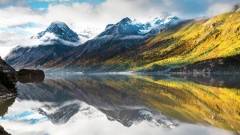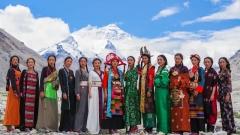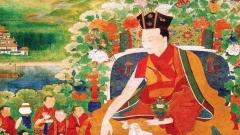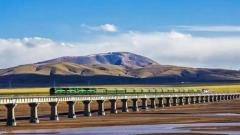Hidden deep in Tibet’s Bomi County, Laigu Glacier is one of China’s most spectacular natural wonders — a vast ice world surrounded by turquoise lakes, forested slopes, and remote Tibetan villages. Each season paints the glacier with a different palette: winter brings crystal-blue ice, autumn glows with golden forests, and spring revives the valley with fresh snowmelt.
For photographers and adventurers alike, knowing when to visit makes all the difference. This seasonal guide reveals how Laigu Glacier transforms throughout the year, what weather to expect, and how to capture its ever-changing beauty.
Winter (November – March): The Blue Ice Wonderland
What You’ll See
Winter is when Laigu Glacier reveals its purest self. The ice hardens and turns deep blue under clear skies, while surrounding peaks shine with fresh snow. The frozen sections of Ranwu Lake mirror the glaciers and clouds, creating surreal, almost dreamlike reflections.
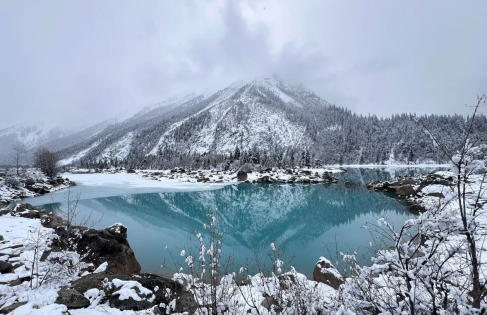
Ranwu Lake
Weather Conditions
-
Temperature: -15°C to 5°C
-
Weather: Mostly sunny and dry, with crisp mountain air
-
Road Conditions: Manageable, though occasional snow requires an experienced driver
Photography Tips
-
Early morning offers the most dramatic blue hues in the ice.
-
Use a polarizing filter to enhance reflections on frozen water.
-
Golden sunlight around 4–6 p.m. creates striking contrast on the snow.
-
Bring extra batteries — the cold drains camera power quickly.
Why Go
Few tourists visit during winter, making it the best time for solitude and pristine views. It’s also perfect for drone photography — crystal-clear skies and minimal wind ensure stable aerial shots.
Spring (April – May): Melting Snow and Rebirth
What You’ll See
As the temperature rises, the glaciers begin to thaw and sparkle, and waterfalls emerge along the cliffs. The meadows below bloom with wildflowers, adding bright colors against the fading snow. This contrast of ice, water, and greenery makes spring one of the most photogenic times to visit.

Weather Conditions
-
Temperature: 0°C to 12°C
-
Weather: Mild days, cool nights; some snowmelt and fog in mornings
-
Accessibility: Roads fully open; less icy than winter
Photography Tips
-
Morning mist over Ranwu Lake creates a soft, painterly atmosphere.
-
Bring a telephoto lens to capture melting streams and mountain wildlife.
-
The golden hour after sunrise is perfect for capturing the interplay of ice and light.
Why Go
Spring symbolizes renewal — the glacier breathes again, and the landscape around Laigu turns alive with color. It’s ideal for landscape photographers seeking texture and contrast in their shots.
Summer (June – August): Green Valleys and Dynamic Skies
What You’ll See
Summer brings lush greenery to Laigu Village and surrounding valleys. Melting snow feeds the rivers, and Ranwu Lake glows in deep turquoise. The glacier is partially veiled by mist, giving it a mystical atmosphere.

Laigu Village
Weather Conditions
-
Temperature: 8°C to 18°C
-
Weather: Warm but humid; afternoon showers are common
-
Visibility: Sometimes limited due to clouds and fog
Photography Tips
-
Best time to shoot: early morning before the clouds gather.
-
The mix of green pastures and icy peaks offers unique compositions.
-
Use ND filters to smooth the waterfalls and streams in long exposures.
Why Go
Summer is ideal for trekking enthusiasts and those who enjoy seeing the coexistence of life and ice. However, weather can be unpredictable — pack rain gear and waterproof camera protection.
Autumn (September – October): The Golden Season
What You’ll See
Autumn is arguably the most beautiful time to visit Laigu Glacier. Forests around Bomi and Ranwu turn golden and red, creating a warm contrast with the white glaciers above. The skies are clear, and reflections on Ranwu Lake are mirror-perfect.

Ranwu Lake
Weather Conditions
-
Temperature: -5°C to 10°C
-
Weather: Dry, crisp air with stable light
-
Travel Comfort: Excellent road conditions; ideal for self-drivers
Photography Tips
-
Combine autumn colors with glacier reflections in your compositions.
-
The best time for lighting: late afternoon, when sunlight adds warmth to icy landscapes.
-
Try drone shots for bird’s-eye contrasts between golden forests and blue glaciers.
Why Go
Autumn is a favorite season for photographers — stable weather, rich colors, and balanced light. It’s also one of the easiest times to travel, with roads clear and temperatures comfortable for exploration.
Seasonal Summary Table
| Season | Temperature Range | Landscape Highlights | Best For |
|---|---|---|---|
| Winter (Nov–Mar) | -15°C to 5°C | Blue ice, frozen lakes, clear skies | Solitude, reflection photography |
| Spring (Apr–May) | 0°C to 12°C | Melting snow, wildflowers, waterfalls | Color contrast, renewal scenes |
| Summer (Jun–Aug) | 8°C to 18°C | Green valleys, turquoise lakes | Trekking, dynamic skies |
| Autumn (Sep–Oct) | -5°C to 10°C | Golden forests, crisp reflections | Landscape photography |
Tips for Visiting and Shooting Laigu Glacier
-
Bring Proper Gear: A tripod, polarizing filter, and wide-angle lens are essential.
-
Dress in Layers: Even in summer, weather can change quickly.
-
Stay in Laigu Village: It offers sunrise views right from your guesthouse window.
-
Travel Responsibly: Avoid stepping onto the glacier without a guide — crevasses are dangerous.
-
Use Local Drivers: Roads are narrow and winding; local experience ensures safety.
Conclusion
No matter the season, Laigu Glacier is a place that rewards patience and respect. Winter’s quiet blue ice, spring’s rebirth, summer’s vitality, and autumn’s golden calm — each offers a different emotional tone for travelers and photographers.
If your goal is to experience Tibet beyond its temples and monasteries, Laigu Glacier delivers the perfect combination of natural drama and spiritual calm — a destination that changes with the light, yet stays timeless in its beauty.




